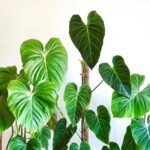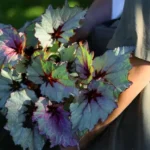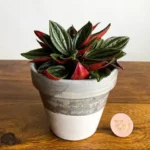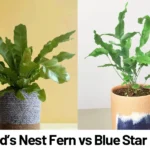Meet the Philodendron Birkin: A Striking Ornamental Hybrid
The Philodendron ‘Birkin’ is a captivating hybrid cultivar prized for its creamy-white pinstriped foliage and compact growth habit. As part of the Araceae family, this decorative indoor plant is ideal for beginners and plant enthusiasts who love stylish, low-maintenance greenery. Originating from the rich biodiversity of tropical South America, Philodendrons have been cultivated for decades due to their adaptability and aesthetic appeal.
‘Birkin’ is not a wild species but a spontaneous mutation of Philodendron ‘Rojo Congo’, itself a hybrid involving P. erubescens in its lineage. First recognized by plant collectors in the early 2000s, the Birkin gained popularity for its variegated foliage pattern which can revert or shift over time, offering an evolving visual interest throughout the plant’s life.
Lighting Requirements for Philodendron Birkin
Proper lighting is essential to maintain the vivid striped pattern of the Birkin’s leaves. While adaptable, this plant thrives best within specific light intensity levels measured in lux.
Ideal Light Intensity Ranges
- Optimal Growth: 5,000–10,000 lux (bright, indirect light from east or north-facing windows, or filtered light through sheer curtains)
- Acceptable Range: 2,500–5,000 lux (moderate ambient indoor light, such as setting back from a west-facing window)
- Minimum Survival Level: 800–2,000 lux (low indoor light, often found in corners or rooms with minimal natural sunlight; leaf variegation may fade)
If natural light is insufficient, especially during winter or in rooms with poor window access, full spectrum LED grow lights rated around 3,000–5,000 lumens and 5,000–6,500K color temperature can effectively supplement light needs. Position lights 20–30 cm (8–12 inches) above the foliage for best results, running them 12–14 hours per day.
Watering Guidelines: Tailoring Frequency to Season, Pot, and Humidity
Overwatering is one of the most common mistakes with Philodendron Birkin. It prefers evenly moist but not soggy soil. Consider the following while planning your watering routine:
Factors That Impact Watering Frequency
- Seasonal Changes:
- Spring/Summer: Water approximately once every 7–10 days
- Fall/Winter: Reduce to every 14–21 days, allowing the top 2–3 cm (1 inch) of soil to dry out
- Pot Size and Material:
- Smaller pots dry faster and may need more frequent watering
- Terracotta pots wick away moisture faster than plastic or ceramic containers
- Humidity: In high-humidity environments (above 65%), soil stays moist longer—extend watering intervals to prevent root rot.
Watering Tip: Always check the soil before watering. Insert your finger 2–3 cm deep; if it feels dry at that depth, it’s time to water. Never let the pot sit in stagnant water—drain any excess.
Temperature and Humidity Preferences
Being a tropical plant, Philodendron Birkin prefers warm and humid growing conditions similar to its native South American rainforest origins.
Optimal Environmental Ranges
- Temperature: 18–27°C (65–80°F) — avoid sudden drops below 15°C (59°F)
- Humidity: 50–70% is ideal. Minimum is around 40%, though higher is better to prevent leaf crisping.
If household humidity drops during winter months, consider placement near a humidifier or a pebble tray filled with water beneath the pot. Grouping plants together can also help maintain higher localized humidity.
Common Problems and How to Fix Them
1. Yellowing Leaves
This often results from overwatering or poor drainage. Ensure the pot has drainage holes and reduce watering frequency. Repot in well-draining mix with perlite or orchid bark if soil remains wet too long.
2. Browning Leaf Tips or Margins
- Cause: Low humidity or salt buildup from hard tap water
- Solution: Increase humidity and water with filtered or distilled water periodically
3. Loss of Variegation
- Cause: Low light conditions
- Solution: Move plant closer to a light source or supplement with a grow light providing 5,000–10,000 lux
4. Stunted Growth
- Cause: Nutrient deficiency or low light
- Solution: Use a balanced, water-soluble fertilizer (e.g., NPK 20-20-20) monthly during growing season and ensure adequate light exposure
Safety Notes: Is Philodendron Birkin Toxic?
Yes, all species in the Philodendron genus, including ‘Birkin,’ are toxic to humans and pets if ingested. The plant contains calcium oxalate crystals, which can cause:
- Oral irritation or burning sensation
- Swelling of the lips, mouth, or tongue
- Vomiting or difficulty swallowing (in severe cases)
Keep the plant out of reach of curious children and pets like cats or dogs. Always wash hands after handling or pruning.
Useful Real-Life Care Tips
1. Rotate Regularly
To promote balanced growth and prevent lopsided foliage, rotate your Philodendron Birkin 90° every two weeks.
2. Choose the Right Potting Mix
Use a well-aerated, chunky mix composed of:
- 40% peat or coco coir
- 30% perlite
- 20% orchid bark
- 10% activated charcoal (optional for odor control)
3. Prune Resets and Reversions
Sometimes the Birkin reverts back to solid green or red foliage (a throwback to its ‘Rojo Congo’ parent). If this happens, prune off fully reverted stems to encourage new variegated growth.
4. Clean the Leaves
Dust can clog the pores of the plant and reduce photosynthetic efficiency. Gently wipe leaves with a damp microfiber cloth every 2–4 weeks to keep them clean and glossy.
5. Repot Every 12–18 Months
Philodendron Birkin enjoys a slightly snug pot. However, once roots start circling the bottom or poking through drainage holes, it’s time to repot into a container 2–3 cm (1 inch) larger in diameter.
Conclusion: Is Philodendron Birkin the Right Plant for You?
If you’re an indoor gardener looking for a visually impressive yet low-maintenance tropical houseplant, Philodendron Birkin is an excellent choice. Its compact size (typically growing up to 50 cm/20 in. tall) and striking variegation make it a standout addition to desks, shelves, or plant stands.
By providing adequate light (ideally 5,000–10,000 lux), consistent moisture, and tropical-level humidity, you’ll enjoy a vibrant, healthy plant that evolves uniquely over time. Just remember to keep it out of reach from pets and small children, and periodically wipe those bold leaves!
References
- Gilman, E. F., & Watson, D. G. (1994). Philodendron spp. Fact Sheet ST-488. University of Florida Institute of Food and Agricultural Sciences. Retrieved from https://hort.ifas.ufl.edu
- Royal Horticultural Society. (n.d.). Philodendron ‘Birkin’. RHS Plant Finder. Retrieved from https://www.rhs.org.uk/plants
- Missouri Botanical Garden. (n.d.). Philodendron. MBG Plant Finder. Retrieved from https://www.missouribotanicalgarden.org








